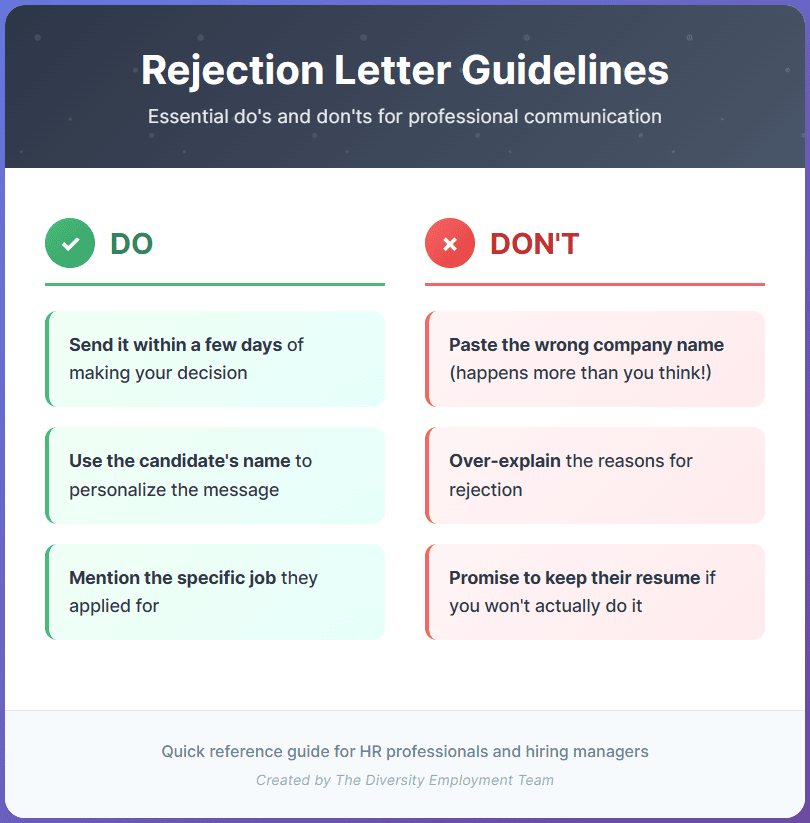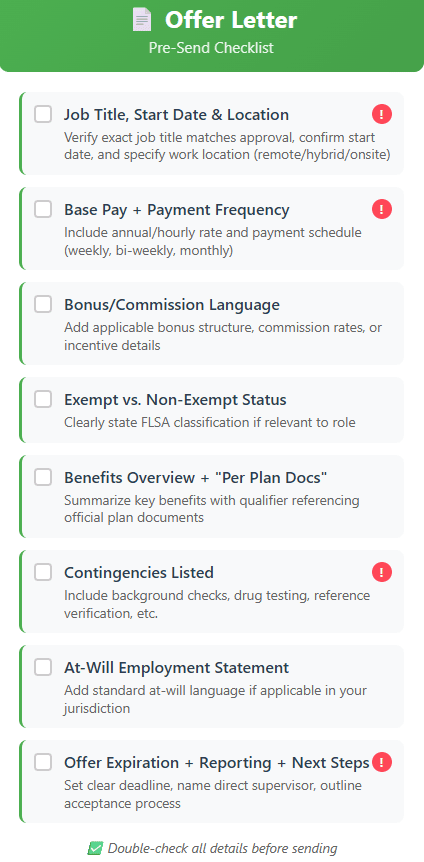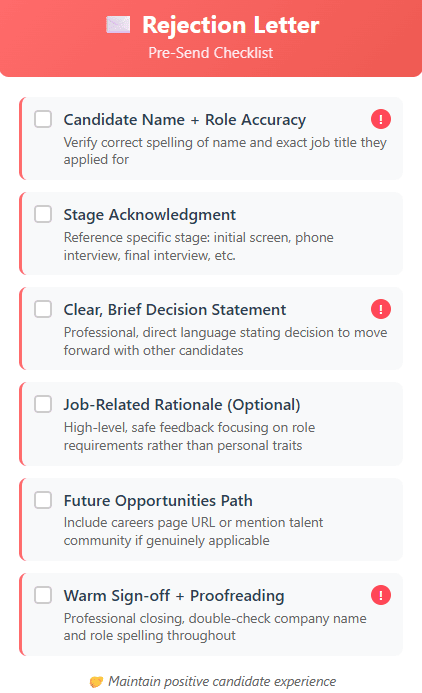Hiring doesn’t end with the handshake after the interview. The last leg of your hiring process is what candidates really remember… and screenshot. A comprehensive and clear offer letter tells your new hires exactly what they’re saying “yes” to. Meanwhile, a timely and respectful rejection letter ends the candidate’s journey, without burning bridges. Both can seriously shape your brand reputation long into the future.
Here’s the catch: small businesses or teams without a dedicated human resources department might simply copy a template off the internet, trim or change a few lines, and just hope for the best. That’s where confusion, and possible legal risks, can sneak in. Vague pay language, missing at-will wording, no deadline to respond, or a ghosted candidate who posts about it online can all affect business reputation.
This guide keeps things simple and relatable. Let’s go over how to: save time, set expectations, and protect your company, while treating people with the decency and professionalism they deserve.
The Offer Letter and Why it Matters
The offer letter is the first official “here’s exactly what we’re offering,” that turns a verbal yes from an interview or phone call, into a concrete contract. It sets clear expectations, reduces back-and-forth, and keeps away from legal risks. It doesn’t have to be too extensive, it just has to be clear.
What to Include
- Job + Basics: Job title, start date, work location (office, hybrid, remote).
- Pay: Salary or hourly rate. If there’s bonus/commission/stock, say how it works at a high level.
- Snapshot of Benefits: Health, retirement, PTO/paid holidays (you can link to the handbook with full benefits/perk details later).
- Contingencies: Background check, drug screen, I-9, references… whatever applies.
- Employment Status: If your state uses at-will work, include that language.
- Deadline: A simple “please respond by [date]” so nobody’s guessing.
- (Optional but helpful) Who they report to and the Team Name. People like knowing where they should be and who they should be with.
Offer Letter Template Sample
Subject: Offer for [Job Title] at [Company Name]
Hi [First Name],
We’re excited to offer you the [Job Title] role at [Company Name]. You’d report to [Manager Name/Title], with a planned start date of [Start Date]. Your primary work location will be [Office, City / Hybrid / Remote].
Compensation
-
Base pay: [Salary or Hourly Rate] paid [Pay Frequency].
-
[Bonus/Commission/Equity]: [Short Description, if applicable].
Benefits (if applicable)
You’ll be eligible for [health insurance], [retirement plan], [paid time off/holidays], and other perks per our policies. We’ll share the full details and eligibility timelines in your onboarding packet.
Contingencies
This offer depends on [background check / drug screen / I-9 / references] being completed successfully.
Employment Status (where applicable)
Employment at [Company Name] is at-will, meaning either you or the company may end the employment relationship at any time, with or without cause or notice, as allowed by law.
Next Steps
Please let us know by [Offer Expiration Date] if you accept. If you do, we’ll send your start-day checklist and onboarding schedule right away.
We’re very excited at the possibility of you joining the team. If you have questions about the position, pay, benefits, or anything else, just ask.
Best,
[Your Name]
[Title]
[Company Name]
[Phone] | [Email]
*Swap in your details and policies: title, pay, dates, contingencies.*
Don’t stuff extras in just to sound “official.” Keep it short, clear, and job-focused. If it doesn’t set an expectation or reduce risk, it doesn’t belong here.
The Art of the Rejection Letter
Being ghosted stings way more than getting a short, honest “not this time.” A clear and succinct rejection letter gives candidates closure, lowers the chance of an awkward follow-up, and it helps keep them willing to apply again, or to other positions. It also protects your employer brand more than most think: people talk, they screenshot, and they remember who treated them well.
Rejection Letter Template Samples
Here are some template samples to help get you started in a few different situations:
Rejection Letter Template Samples
Core Principles
- Be Timely: Send within 1 to 3 business days of the decision. For high-volume jobs, batch letters once daily so nobody accidentally lingers for weeks.
- Be Specific Without Being Risky: Name the position, stage, and outcome. Avoid personal critiques or protected-class language.
- Keep it Real: Use the candidate’s name, reference something real (the role, an interview topic, a work sample).
- Don’t Over-Promise: Only say “we’ll keep your resume” if you actually tag it and nurture in your ATS/CRM.
- Offer a Next Step (only when it’s true): Link your careers page, talent newsletter, or a job category they’re better suited for.
- Consistency = Fairness: Use the same measurements for everyone at the same stage. It gives process, not on a whim.
- Accessibility & Inclusion: Plain language, short paragraphs, readable on mobile. No idioms that could be exclusive. Keep the door open for everyone.

Helpful Process Tips
- Subject Lines That Won’t Sting: “Update on your application for [Company] ,” or “Thank you for interviewing for [Job Title].”
- Send Time: Mid-morning or mid-afternoon always beats Friday 5pm. Also, avoid all major holidays.
- Tags to Use in Your ATS/CRM: Rejected – Stage: Screen, Rejected – Stage: Panel, Silver Medalist, Revisit Q4.
- Nurture Path: Silver-medalists → add to “First to Know” list for new jobs; set a 60-day check-in task.
Common Mistakes to Avoid
Quick note: this is practical guidance, absolutely not legal advice. Laws vary by state. Always run final language past legal counsel or your Human Resources professional.
Legal pitfalls (easy to miss, painful to fix)
Promising things you don’t mean to contractually guarantee.
- Risk: Courts may treat “guaranteed annual bonus” or “minimum one-year employment” like a promise.
- Fix: Use plain, precise phrasing: “…eligible for a discretionary bonus based on company and individual performance.”
Skipping the at-will statement (where applicable).
- Risk: Candidate argues there was an implied term of continued employment.
- Fix: Add a clean, stand-alone paragraph: “Employment at [Company] is at-will…”
Getting pay language wrong.
- Risk: Wage claims, pay-equity issues, or confusion about exempt vs. non-exempt tax status.
- Fix: State base pay + pay frequency, note overtime eligibility for non-exempt roles, avoid hedging terms like “around $X.”
Leaving out contingencies.
- Risk: Disputes if a background check or I-9 fails.
- Fix: List Conditions that must be met: passed background check, drug screen (if used), I-9, references, conflict checks.
Using discriminatory or coded language.
- Risk: Bias or discrimination claims.
- Fix: Keep offer & rejection letters strictly job-related. Avoid age, health, family status, immigration comments, or anything touching protected classes.
Including benefits specifics that can change without notice.
- Risk: “You will receive X plan forever” can box you in.
- Fix: “You will be eligible for benefits per plan documents; plans may change.”
Failing to set an expiration date.
- Risk: Offers hang open while you pause the hiring process.
- Fix: A simple: “Please respond by [date] or this offer will expire.”
Export Controls / Moonlighting / Intellectual Property ownership left unsaid (role-dependent).
- Risk: IP disputes, especially when created outside of normal business hours or while moonlighting, even legal compliance issues later-on.
- Fix: Add information on where to find to standard inventions/confidentiality policies; include export-control notes for certain jobs (particularly ones involved with restricted technology, products, or software).
Tone & empathy traps (both letters)
Ghosting.
- Problem: Candidates remember and call out silence much more than a quick “no.”
- Fix: Batch rejection letters daily; even a two-paragraph note can work.
Robotic or “legalese”-heavy wording.
- Problem: It just reads cold; potentially hurts your brand.
- Fix: Use short sentences, headers, and maybe even some empathy (“Thanks for your time…”).
Over-explaining the “no.”
- Problem: Invites unnecessary debate or falling into a situation with legal risk.
- Fix: Name the position, stage, decision, and (optionally) a job-related focus area, as long as it’s done for all candidates at the same stage.
Accidental one-size-fits-all.
- Problem: Using the same email for entry-level, executive, and hourly jobs can be enough, but it feels tone-deaf.
- Fix: Keep 3–4 variants (screen, interview, silver-medalist, paused requirement) and adjust them when new requirements come up.
Making promises about the future.
- Problem: “We’ll definitely reach out.” becomes a commitment.
- Fix: “We’d welcome an application in the future,” or “You can join our talent list here.”
“Instead of / Try” (Quick Rewrites)
- Instead of: “We went with a better cultural fit.”
Try: “We’re moving forward with a candidate whose recent experience aligns more directly with [specific requirement].” - Instead of: “Salary will be around $70k.”
Try: “Base salary: $69,500 per year, paid bi-weekly.” - Instead of: “Permanent employment with benefits including…”
Try: “Employment is at-will. You’ll be eligible for benefits per plan documents…” - Instead of: “We’ll keep your resume on file.”
Try: Just skipping it, or “If you’d like, we can add you to our first-to-know list for [team/role].” (Again, only as long as it’s true).
Winning in the Last Mile of Hiring
You don’t need a big HR team to have a good brand, be recognized as an equal opportunity employer and truly feel sincere to job seekers. A clear offer letter sets expectations and avoids messy back-and-forth.

Offer Letters
- Lock in the basics: title, pay, start date, location, contingencies.
- Reduce misunderstandings and legal risks with clean, plain language.
- Start the relationship on the right note… No mystery, no surprises.
On the other hand, a timely rejection letter closes the door with respect. Together, they shrink risk, save time, and leave candidates with a better story to tell about your company.
Rejection Letters
- Protect your brand: people remember (and share) how you say “no.”
- Cut down on follow-ups and guesswork for everyone.
- Keep doors open: invite strong candidates to reapply or join your talent list.
FAQs
Here’s a common list of questions with quick answers for busy employers and hiring teams. Also, consider reading through our article on “Job Posting Red Flags.” Make sure your verbiage isn’t scaring away talented candidates before they even apply!
Do I have to send a rejection letter?
There’s no law requiring it in most places, but you should. It protects your brand, reduces timely follow-ups, and keeps good candidates ready and willing to reapply.
Is email enough, or do I need a formal letter?
Email is standard and perfectly fine. Save a few different PDFs for executive roles, relocation packages, or complex equity terms.
Are offer letters legally binding?
They can be treated like contracts if you make promises. Keep language precise (“eligible for,” “discretionary,” “per plan documents”) and include the at-will statement where applicable.
What absolutely MUST be in an offer letter?
Title, start date, location; base pay & pay frequency; exempt vs. non-exempt (if relevant); benefits overview (with “per plan documents” qualifier); contingencies; at-will statement; expiration date; who they report to; and the next steps.
How fast should I send rejection letters after interviews?
Within 1–3 business days of the decision. It can help to batch your rejection letters once per day for high-volume jobs.
Should I give reasons for rejection?
Keep it professional and job-related (“closer match to X requirement”). Avoid personal feedback in most cases, unless you offer it consistently and can stand behind it.
What if the candidate wants to negotiate?
Acknowledge, ask for specifics (base, bonus, start date, PTO), and respond once you’ve checked internal ranges and equity. If you can’t move, offer non-cash levers (title clarity, learning budget, review at 6 months, etc.).
Do I need a deadline in the offer letter?
Yes. It prevents the offer from lingering while you pause looking for another person. A common time-frame is 3-7 calendar days.
What contingencies should I list?
Background check, I-9 eligibility, professional references, drug screen (if used), conflict checks/export controls (role-dependent). Put them in writing, clear and to-the-point.
Can I rescind an offer letter if something changes?
You can, but it’s generally risky and not a good look. If you have to… Document the reason (e.g., failed contingency, budget freeze), communicate promptly and respectfully, and check through all jurisdictional rules first.
Where do pay-transparency laws come in?
Some states/cities require posting ranges and/or sharing range on request. If your position falls in those jurisdictions, include the range and a short note on how pay is determined (skills, experience, location, etc.).
How do I phrase the at-will statement?
Keep it simple and standalone: “Employment at [Company] is at-will; either you or the company may end employment at any time, with or without cause or notice, as permitted by state law.”
Should I attach the full benefits summary?
A brief overview in the offer letter is good enough. Link or reference where full documents and eligibility timelines can be found, so if the details change there’s no rewriting whole offer letters.
Can I use one rejection letter template for everyone?
It’d much better to keep a few variants: resume screen, post-interview, silver-medalist, paused/cancelled position, hourly/high-volume. Those small adjustments = a big lift in the candidate’s experience.
Is it okay to say “culture fit”?
Generally, no. Skip it. It’s vague and potentially risky. Use job-related language: “more direct experience with [specific requirement].”
What about offer letters for interns, temps, or contractors?
Use job-specific offer letters: include program dates, hourly pay or stipend, overtime eligibility (if any), and who supervises. For agencies/contractors, clarify who is the employer of record.
Do I need e-signatures?
Not required for most jobs, but e-sign does speed things up and helps reduce errors… Even a typed “I accept” by email can work; just align it with your HR process.
Should I promise feedback to every candidate?
Only if you can deliver consistently, equally, and safely. If you do provide feedback, keep it brief, specifically job-related, and consistent across every candidate.
How long should I keep candidate data/emails?
Follow your retention policy and local laws (often 1-3 years). Store your decisions and interview materials in your ATS/HRIS, never somewhere deep in a random personal inbox folder.
Can I include a probationary period?
If you do, make sure it follows local laws and doesn’t undermine or clash with at-will language. Frame it as an introductory period with performance check-ins.
What if the start date needs to move?
Send a short amendment email confirming the new date and that all other terms remain the same.
We’re remote… How do I handle “location”?
State the primary work location as “Remote, based in [State/Country]” and note any required time zone coverage or in-office presence for team events and workplace diversification.
Equity language scares me, how detailed should it be?
Keep the letter professional (“eligible for an option grant subject to Board approval; details per plan documents”). Put the specifics in a grant notice/plan.
Is it okay to send a rejection letter but invite them to reapply?
Yes, but only if you really mean it. Offer an actionable next step: career page link, join your talent community, or permission to tag them as a silver-medalist in your ATS.





